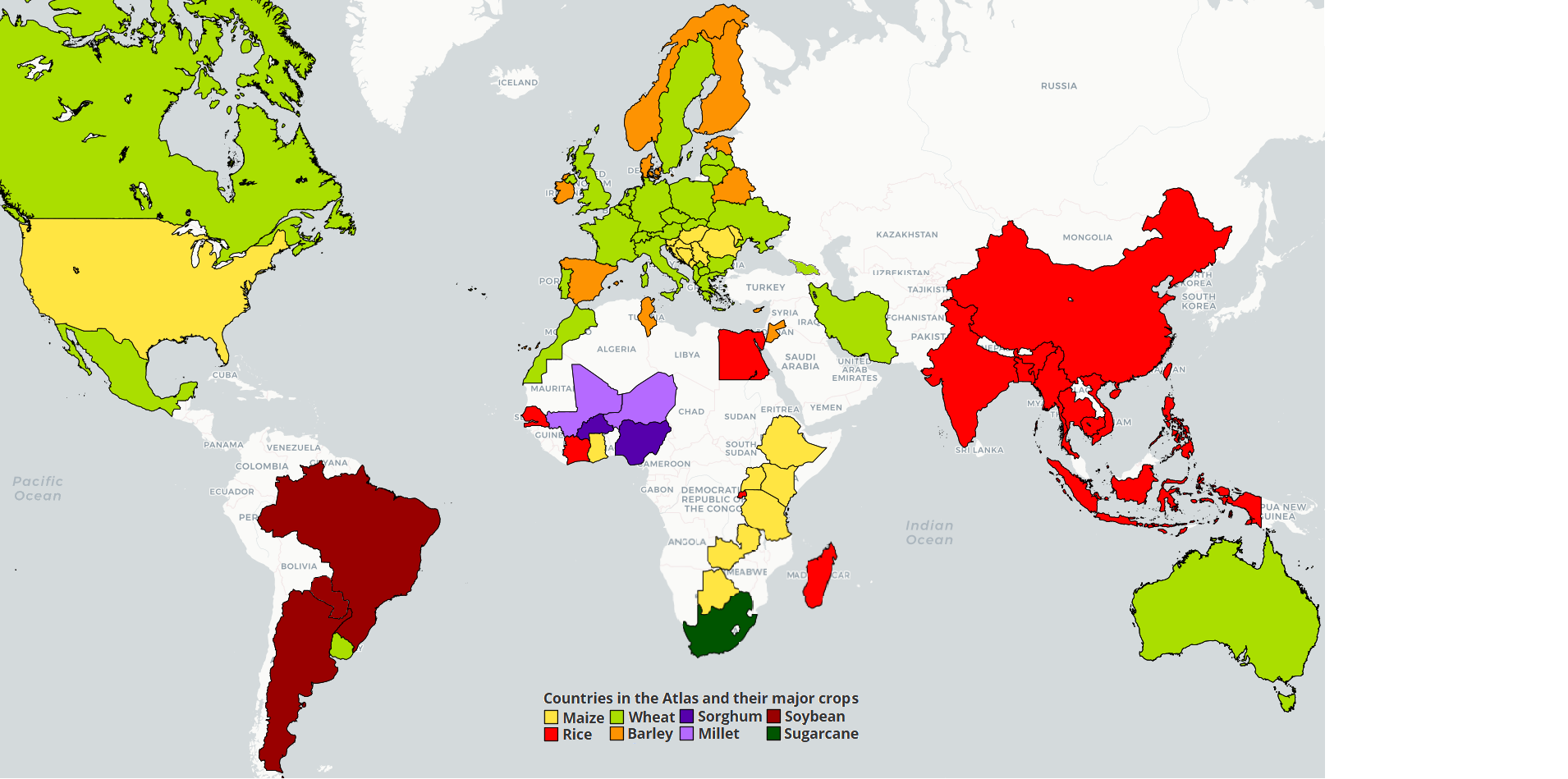 Paraguay
Paraguay
Description of cropping systems, climate, and soils
Harvested crop area in Paraguay occupies nearly 5 million ha. Major crops are soybean, wheat and maize, which account for ca. 90% of total crop area, and the country is one of the largest producers and exporters of these crops.
Table 1. Average (2016-2021) total production, harvested area, and average yield of maize, soybean, and wheat in Paraguay. Source: Ministry of Agriculture and Livestock (https://www.mag.gov.py/index.php/institucional/dependencias-1/series-historicas).
| Crop | Production | Harvested area | Yield |
| (M t) | (M ha) | (t/ha) | |
| Maize | 4.0 | 0.9 | 4.1 |
| Soybean | 10.5 | 3.6 | 2.8 |
| Wheat | 0.9 | 0.4 | 2.0 |
Paraguay has a favorable climate for rainfed crop production, especially in the eastern region, with total annual rainfall that ranges, from 600 (north-west) to 2000 mm (south-east). Despite the potential for irrigation expansion, current irrigated area is negligible (2% of total area planted with maize, soybean, and wheat). The soils of Paraguay are fertile in the Chaco (west region), while weathered soils dominate in the eastern region, predominating Podzolic Soils (Ultisols), Structured Red Earths (Oxisols and Alfisols), Planosols (Alfisols), Quartz Sands and Lithosols (Entisols) and Solonetz (Aridisols). A detailed description of weather and soil can be found in Grassi (2020), Lopez et al., (1995) and World Bank (2018). Remarkable features of the agricultural sector in Paraguay are: (i) accounts for 30% of the gross domestic product and 40% of national exports, (ii) employs 40% of the hired labor in the country, (iii) most crops are produced on a soybean-cereal rotation that includes two crops per year, and (iv) no-till has been widely adopted in the country.
Selection of buffers and weather data
Following the GYGA protocols, a total of 11 (maize and soybean) and 7 (wheat) reference weather stations buffers were selected based on the distribution of harvested area for each crop, climate zones, and the location of the meteorological stations belonging to the Direction of Meteorology and Hydrology (DMH; https://www.meteorologia.gov.py/emas/). Selected buffers include >70% of the total harvested area for each of the three crops in Paraguay, while the CZs where these buffers are located represent >97% of the national crop area. For the selected stations, we retrieved 15+ years of measured daily weather data (2007-2022), including daily maximum and minimum temperature, dew point, wind speed and precipitation. Incident solar radiation was retrieved from NASA-POWER (https://power.larc.nasa.gov/).
Soils
The database used to determine the main soil types for each region was provided by the Land Use Rationalization Project (PRUT, 1995) by the Ministry of Agriculture and Livestock. Using the harvest area maps provided by Spam.v2, the main agricultural soils were identified. Briefly, a two-step procedure was followed: first, national soil maps (1:500,000) were used to calculate the area of all soil series within the buffer, and (ii) 2-3 dominant soil series were selected for crop simulations based on the relative area within the buffer, land use suitability, and farmers' choice of soil for growing a given crop. The physical characteristics of the soils present in the data provided by the Ministry of Agriculture and Livestock were cross-referenced with information from the Faculty of Agricultural Sciences’ soil database, which has descriptions of soil profiles for each of the selected buffers. Soil inputs needed for crop simulations include soil texture and rootable soil depth. For the eastern region of Paraguay, calibrated pedo-transference functions for tropical soils were used to derive soil water limits (Tomasella et al., 2000) field capacity was set at -10 kPa following the observations for tropical soils by Tomasella and Hodnett (2004), whereas in the western region of Paraguay (Chaco) we used the pedo-transference functions developed for temperate soils by Ritchie and Crum (1988). Because of low pH in the subsoil, the rootable soil depth was set at 80 cm, except for the buffers located in the western part of the country and those in the central part of the country with sandy and sandy loam textures, where rootable soil depth was set at 120 cm. Resulting soil profiles for each soil type in each buffer were cross validated by local experts from private and public sectors.
Crop management
Management practices for each RWS buffer zone were retrieved from local agronomists. Requested information included average planting dates, dominant cultivar name and maturity, and actual and optimal plant population density. The provided data were subsequently corroborated by other local and national experts.
For maize and soybean, we simulated both the first-crop season (“safra”) and second-crop season (safrinha) in each buffer. For each crop-buffer combination, all crop sequence x soil type combination were simulated, and then weighted by their relative proportion to retrieve an average Yw at the buffer level. Simulations assumed no limitations to crop growth by nutrients and no incidence of biotic stresses such as weeds, insect pests, and pathogens. All simulations were for rainfed crops.
Simulations for each buffer were based on 15 years of weather data (2007-2022). To account for differences in initial soil moisture at planting time between years, the most typical crop sequences were simulated in each buffer, assuming 100% of available soil moisture in the first year of the series (2007), while subsequent seasons considered the available soil moisture at the end of the preceding crop and accounted for precipitation during the fallow period and the next crop cycle. To simulate every crop species in each year, we run simulations starting with all possible phases of each crop rotation. Separate simulations were conducted for each of the selected soils in each buffer.
Simulations were conducted for widespread cultivars in each buffer using CERES-Maiz, CERES-Wheat, and CROPGRO-Soybean models embedded in DSSAT v 4.7 (Jones et al., 2003; Hoogenboom et al., 2019). Models were evaluated on the ability to reproduce measured phenology and grain yields in well-managed experiments in Paraguay, showing satisfactory performance. Simulated soybean cultivars include maturity groups from 5.5 to 6.5, maize hybrids of 125 to 130 days, and an intermediate wheat crop cycle, which portray well the crop cycle length of most dominant crop cultivars sown by farmers. Genetic coefficients were previously derived and validated by Monzon et al. (2007, 2012) and Aramburu Merlos et al. (2015) based on data from rainfed and irrigated experiments.
A weighted average yield was calculated for each buffer based on the relative contribution of each crop sequence and each soil to the crop harvested area within the buffer. Reported Yw in the Atlas are long-term averages. Yield gap (Yg) was calculated as the difference between long-term average Yw (rainfed crops) and average (2017-2022) farmer yield. In the case of soybean, separate results of yield potential and yield gaps are shown for first- and second-crop soybean, as well as the aggregate results pooling the results from the two crop cycles.
Actual yields
Department-level data on harvested area and average yields for each crop were obtained from the Ministry of Agriculture and Livestock (https://www.mag.gov.py/index.php/institucional/dependencias-1/series-historicas). Statistics from the last five available crop growing seasons (2017/18 to 2021/22) were used to calculate average yields in each buffer for maize, wheat, and soybean. These yields were cross-validated using data from producer organizations and private companies, showing a reasonable level of agreement.
Acknowledgements
We thank AGROTEC, CORTEVA, BAYER, SYNGENTA, UPL, AGRONÓMICO, FEPASIDIAS and USDA FAS for the technical and/or economic support to the development of the atlas in Paraguay and AGROTEC and CORTEVA for the installation and management of experimental soybean and maize plots that allowed the calibration and validation of the CROPGRO-Soybean and CERES-Maiz. We also thank IPTA and Lauro Oscar Benkenstein for sharing wheat experiment data that allowed the calibration and validation of the CERES-Wheat model.
References:
Aramburu Merlos, F., Monzon, J.P., Mercau, J.L., Taboada, M., Andrade, F., Hall, A.J., Jobbagy, E., Cassman, K.G., Grassini, P. 2015. Potential for crop production increase in Argentina through closure of existing yield gaps. Field Crops Research 184, 145-154.
Grassi, B. 2020. Estudio del Clima Paraguay 2019. MADES-STP. Asunción, Paraguay.
Hoogenboom, G., Porter, C.H., Sheila, V., Boote, K. J., Singh, U., White, J. W., Hunt, L.A., Ogoshi, R., Lizaso, J.I., Koo, J., Asseng, S., Singels, A., Moreno, L.P. and Jones, J. W. 2019. Decision Support System for Agrotechnology Transfer (DSSAT) Version 4.7. DSSAT Foundation, Gainesville, FL. Available at: www.DSSAT.net.
Jones, J.W., Hoogenboom, G., Porter, C.H., Boote, K.J., Batchelor, W.D., Hunt, L.A., Wilkens, P.W., Singh, U., Gijsman, A.J., Ritchie, J.T. 2003. The DSSAT Cropping System Model. Eur. J. Agron. 18: 235–265.
López, O.; González, E.; Llamas, P.; Molinas, A.; Franco, E.; García. S.; Ríos, E. 1995. Estudio de reconocimiento de suelos, capacidad de uso de la tierra y propuesta de ordenamiento territorial preliminar de la Región Oriental del Paraguay (PRUT). Asunción, PY: MAG/SRNMA/BM/PRUT. v.1, 197 p.
Monzon, J.P., Sadras, V.O., Abbate, P.A., Caviglia, O.P. 2007. Modelling management strategies for wheat-soybean cropping systems in the Southern Pampas. Field Crops Res. 101, 44-52.
Monzon, J.P., Sadras, V.O., Andrade, F.H. 2012. Modelled yield and water use efficiency of maize in response to crop management and Southern Oscillation Index in a soil-climate transect in Argentina. Field Crops Res. 130, 8-18.
Ritchie, J.T., Crum, J., 1988. Converting soil survey characterization data into IBSNAT crop model input. In: Bouma, J., Bregt, A.K. (Eds.), Land Qualities inSpace and Time. Proceedings of a Symposium Organized by the InternationalSociety of Soil Science (ISSS). Wageningen, the Netherlands, 22–26 August1988. Pudoc, Wageningen, pp. 155–167.
Tomasella, J, Hodnett, MG, Rossato, L, 2000. Pedotransfer functions for the estimation of soil water retention in Brazilian soils. Soil Sci Soc Am J 69, 649-652.
Tomasella, J, Hodnett, 2004. Pedotransfer functions for tropical soils. In: Developments in Soil Science, pp. 415-429.
World Bank. 2018. Implementación de un Sistema de Información Agroclimática en Paraguay. Asunción, Paraguay. Disponible en: https://documents1.worldbank.org/curated/en/541291535711285259/pdf/Informe-Final-IICA.pdf
Get access to the Atlas for advanced users
Download GYGA results
 | Please read the license information in case you are interested in using the data from the Global Yield Gap Atlas. |
| read more>> |
 Country agronomist
Country agronomist
|
Maria Soledad Armoa Baéz, MSc. Facultad de Ciencias Agrarias, Universidad Nacional de Asuncion (FCA-UNA)
|
|
Dr. Eduardo Lago Tagliapietra Universidad Federal de Santa Maria |
|
Dr. Alencar Junior Zanon Universidad Federal de Santa Maria
|
|
Dr. Juan Pablo Monzon Consejo Nacional de Investigaciones Cientificas y Tecnicas (CONICET) |





